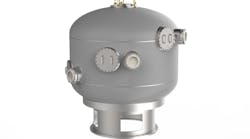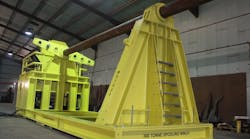TotalEnergies starts construction of first wind farm in France
TotalEnergies has started construction of the Eolmed project, in which TotalEnergies has a 20% stake. This 30-MW project is located more than 18 km off the coast of Gruissan and Port la Nouvelle (Occitan region). The start of production is expected by 2024.
The wind farm will consist of three 10-MW wind turbines mounted on steel floats and connected to the French Electricity Transmission Network by an underwater cable.
The project, operated by Qair, meets the objectives of the partners to ensure its good environmental integration and to promote the know-how of the Occitanie Region thanks to the involvement of all the stakeholders. Eolmed is part of the Occitanie Region's strategy to relocate industrial production. The consortium has chosen a joint venture (JV) formed by Matière and Ponticelli to produce the floats in Bagnac-sur-Célé (Lot) and Port-la-Nouvelle (Aude). This JV will benefit from the port's new infrastructure and will mobilize more than 600,000 man-hours of work across Occitania.
This project is part of TotalEnergies’ strategy to develop floating wind energy, which allows access to deeper sites, further from the coast, and to take advantage of greater wind resources.
The company is developing this technology in France and abroad through several projects at different stages of development:
Heerema aiming to simplify floating offshore wind installations
Heerema Marine Contractors has developed a new technique for installation of floating offshore wind structures.
Current proposals involve assembling floating foundations in port before a wet-tow to the offshore location. According to the company, this brings logistical challenges, and restrictions in terms of the number of suitable harbors.
The new “Floating to Floating” installation method does not require a wet-tow and dispenses with the need for marshalling yards. It allows floaters to be constructed on land before being dry-towed on a transport vessel to the location.
On arrival, Heerema will employ a floating installation frame to lift the floaters from the vessel, and then perform the installation. The frame submerges the floaters down by weight, removing the need for ballasting or tensioning systems and also reducing the duration of the installation.
Bottom foundation work can be executed in parallel through optimizing the capabilities of Heerema’s semi-submersible crane vessels, the company added. The floaters’ volume and weight are said to be reduced through removals of the need for wet-towing. And with the floater being lifted directly from the transportation vessel at the offshore location, both the floater and wind turbine generator can be optimized for in-place conditions.
In addition, the solution enables a “low-tech” floater design through integrating installation needs such as ballasting provisions into re-usable installation tooling, without the imperative to build these functionalities into each floater. According to Heerema, using space onboard transport vessels to deliver multiple floaters directly from the fabrication yard to the offshore wind site transport cuts marshalling costs. And removing the need for in-port assembly of the floater means that less space and draught is required in the port.
Without time-consuming and weather-sensitive wet tows and mooring connections, higher throughput is possible on floating wind projects, the company claimed.
The crane-supported floating to floating installation method is based on proven technologies from the oil and gas floating platform sector, enabling savings of tons of steel per floater and reduced project capex, Heerema concluded.
BW Ideol, Tohoku Electric Power form floating wind venture
BW Ideol and Tohoku Electric Power have initiated feasibility studies for a joint development of a commercial-scale floating offshore wind farm offshore Kuji City in Japan’s Iwate prefecture.
The development will feature BW Ideol’s Damping Pool technology. The two companies will pursue early commercialization of cost-competitive floating offshore wind power in Japan through this venture, according to BW Ideol.
Tohoku Electric Power is a Japanese utility founded in 1951. Under the Tohoku Electric Power Group Carbon Neutral Challenge 2050, it will seek to accelerate CO2 emissions reductions by maximizing use of renewable energy and nuclear power.
Its target is to develop 2 GW of wind power capacity, mainly in the six Tohoku prefectures and in Niigata prefecture.





